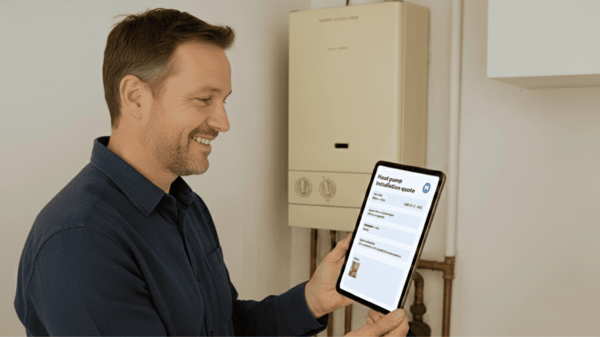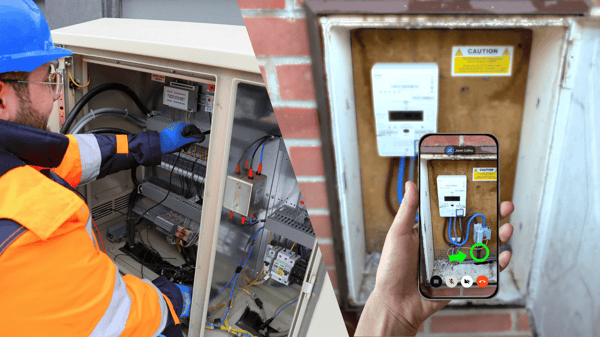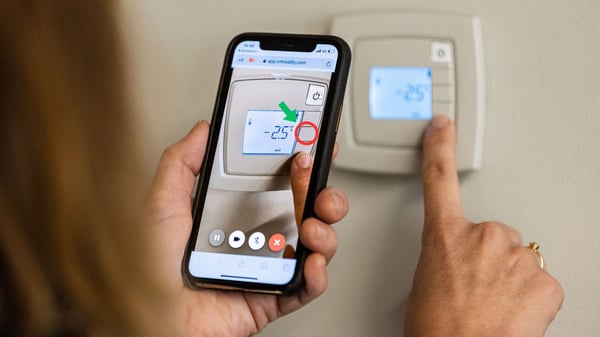In the realm of service operations, a crucial term that often comes up is "truck roll." But what exactly is a truck roll, and why is it significant for companies employing service technicians to know how they can reduce their truck rolls? That's what we will cover in this article.
In simple terms, a truck roll refers to the dispatching of a service technician to a customer's location to address an issue or perform a task. These tasks can range from routine maintenance to troubleshooting and repairing complex systems.
Do not be misled by the term "truck roll," which may suggest that only technicians dispatched by truck are involved. In reality, this term encompasses various modes of transportation, including trains, flights, and buses. What truly defines a truck roll is the dispatch of a technician to travel to a different site, frequently that of a customer.
Effectively managing truck rolls involves strategic planning, efficient scheduling, and leveraging technology to streamline processes. By doing so, companies can maximize the productivity of their service technicians, minimize downtime for customers, and ultimately enhance the overall service experience.
Understanding the concept of a truck roll is fundamental for companies seeking to optimize their service operations and deliver unparalleled support to their clientele.
The sometimes hidden costs of truck rolls
For companies managing service technicians, the decision to initiate a truck roll should not be taken lightly. Each truck roll represents an investment of time, resources, and manpower.
Therefore, optimizing truck rolls is paramount for enhancing operational efficiency and minimizing costs.
When you think about what comprises the cost of a truck roll, you most likely think of the following:
The Technician Labor Costs:
- Time spent by the technician traveling to the customer's location.
- Time spent on-site performing diagnostics, repairs, or maintenance.
Travel Expenses:
- Fuel costs for the vehicle used for transportation.
- Toll fees, parking fees, and other miscellaneous travel expenses.
- Tickets costs for flights, train, taxi or busses.
But there are several other, more hidden, costs associated with each truck roll, such as:
Vehicle Depreciation:
- Wear and tear on the vehicle used for transportation leads to decreased resale value over time.
Opportunity Costs:
- Time spent on the truck roll that could have been utilized for other tasks or assignments.
- Potential revenue lost due to the technician's unavailability for other jobs during the travel and on-site service.
Administrative Costs:
- Coordination and scheduling costs associated with planning the truck roll.
- Administrative overhead related to documenting and processing the service visit.
Environmental Costs:
- Environmental impact associated with vehicle emissions and fuel consumption during travel.
In this survey by nClarity, a majority of the respondents state that the average cost of a truck roll is above $850. But this most likely only includes the obvious costs associated with a truck roll. Considering the hidden costs listed above, we can assume the actual cost for an average truck roll to be even higher.
Understanding and managing these costs effectively is crucial for optimizing the efficiency and profitability of truck roll operations within a service organization. So, let's take a look at how you can do that!
Three ways to reduce truck rolls
Reducing truck rolls has two major benefits for your company. Firstly, it lowers the costs mentioned above by reducing the number of dispatched technicians and enhancing the efficiency of those dispatched.
Secondly, if done smartly, it will also enhance customer satisfaction. When technicians must revisit to address recurring issues, it adversely affects customer satisfaction. Individuals who encounter negative experiences with a company, whether through customer service interactions, multiple technician visits, equipment malfunctions, or a combination thereof, are less likely to remain loyal.
Here are three actions that will help you reduce truck rolls while simultaneously improving customer satisfaction:
1. Create user-friendly self-service tools for your customers
Reduce the need for truck rolls by introducing interactive troubleshooting guides and an extensive online knowledge base that your customer can use. These user-friendly tools can empower customers to tackle common issues independently.
With step-by-step instructions and guides tailored to address the most common issues encountered with your company's products or services at their disposal, customers can diagnose and resolve some issues without the need for technician intervention. Equipping customers with these resources significantly decreases reliance on truck rolls. It's a proactive approach that streamlines support processes and fosters customer autonomy and satisfaction.
According to Forbes, many customers today prefer to start with a self-service option before calling support; thus, not offering an online knowledge base or similar could even have a negative effect on customer experience. Therefore, creating self-service options for your customers should be considered regardless of whether you strive to reduce truck rolls. But who doesn't like a two-for-the-price-of-one deal?
2. Optimize schedules and routes
Companies can significantly reduce truck rolls and associated expenses by strategically planning and organizing technician deployments.
Try to optimize schedules and routes by grouping appointments geographically to minimize travel time and distance between locations. This allows technicians to complete more service calls within a given timeframe. By minimizing downtime between appointments and eliminating backtracking, technicians can maximize their productivity and attend to a higher number of customers each day. If you want software that helps you with this, check out G2's listing of the most popular options here.
Having a clear plan for efficient scheduling also ensures that technicians arrive promptly at customer locations on scheduled time. By providing customers with shorter appointment windows and reliable service times, companies can enhance customer satisfaction and loyalty by minimizing the disruption to customers' daily routines.
Optimizing routes saves on costs and reduces the environmental impact of truck rolls. By minimizing fuel consumption and vehicle emissions, companies can contribute to sustainability efforts and reduce their carbon footprint.
3. Use remote video support as an alternative to physical visits
There are scenarios where the two options above are not applicable. The customer can't solve the issue themselves, and it's urgent, so you can't postpone helping them until it's aligned with other visits in the area. That's why remote video support is a great tool in your toolbox.
Technicians can use video support tools to remotely diagnose and troubleshoot issues with customers' equipment or systems. Customers can visually demonstrate the issue they're experiencing, providing technicians with valuable context to understand better and address the problem effectively.
By visually inspecting the problem through a live video feed, technicians can often identify the issue and provide guidance for a resolution without needing an on-site visit. If the issue can't be solved remotely, it might require a spare part or be complex to solve; the technician will arrive at the customer much better prepared with the right equipment needed to address the issue. In the study conducted by nClarity, the vast majority of respondents agreed that some truck rolls could have been avoided if the technician had known the diagnosis of the problem prior to dispatch.
Therefore, remote video support should always be your first course of action when a customer calls about a technical problem. It will help you solve some issues directly over the call, and when you need to dispatch a technician, they can arrive fully aware of the nature of the problem and bring the right equipment to fix it.
How much can you save by reducing truck rolls?
Notice that we are talking about reducing truck rolls, not eliminating truck rolls. The need for truck rolls is real and will arise when remote diagnostics or troubleshooting methods fail to resolve an issue satisfactorily. Whether due to the problem's complexity, the necessity of physical equipment, or regulatory requirements, dispatching a technician becomes the most viable solution to ensure customer satisfaction and maintain service quality.
So you can't take truck rolls out of the picture. That said, optimizing when and how you dispatch your truck rolls is key to efficient operations. You can save both money and time, and let's not forget about CO2, by reducing truck rolls.
The most simple way to estimate how much you can save per month is to start by summarizing the obvious costs you have today for truck rolls:
Technician labor cost + Travel cost = Cost per truck roll
Cost per truck roll * Number of truck rolls per month = Total cost per month
By implementing action 2, efficient scheduling, you can reduce the cost for each truck roll and thus lower the total monthly cost. How much depends on the nature of your customer base and the frequency of visits.
Usually, you also have a known number of No Fault Found (NFF) dispatches and a known number of return visits due to the technician not having the right equipment to fix the issue. By implementing actions 1 and 3 above, you can reduce many of these truck rolls.
(Number of NFF dispatches per month + number of return visits) * Cost per truck roll = Potential monthly savings
This gives you a clear indication of how much your company could potentially save each month.
Real-life examples of reduced truck rolls and associated savings
Companies that have implemented action three by using XMReality's remote video support software have reduced truck rolls and made their support more efficient.
One example is Sovereign Housing, which solved 26% of its tickets remotely instead of having to dispatch a technician.
Toshiba America Business Solutions saves over $5,000 each month on reduced truck rolls, adding up to the impressive sum of 60,000 dollars per year.
Tekniska Verken solves more tickets per technician by using remote video support to replace part of their truck rolls, highlighting how you can reduce opportunity costs and have each technician solve more issues.
The time to act is now
In conclusion, reducing truck rolls is not just about cutting costs; it's about optimizing efficiency, enhancing customer satisfaction, and contributing to sustainability efforts. By implementing user-friendly self-service tools, optimizing schedules and routes, and leveraging remote video support, service managers can significantly lower operational costs while improving the overall service experience for their customers.
In addition to the strategies outlined above, we suggest using data analytics and performance metrics. Service managers can gain valuable insights into the efficiency and effectiveness of their truck roll processes by tracking key metrics such as response time, resolution time, first-time fix rate, and customer satisfaction scores.
Analyzing this data allows you to identify trends, pinpoint areas for improvement, and make data-driven decisions to optimize operations. Ensuring that you always strive for excellence in service delivery.
If you're ready to take your service operations to the next level, save time and money, and reduce your carbon footprint, contact XMReality today to learn how our remote video support software can help you achieve your goals.







